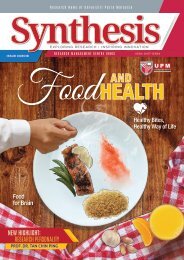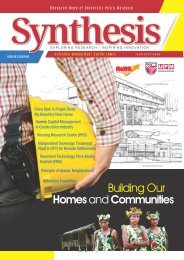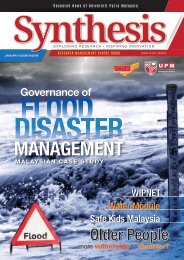SYNTHESIS ISSUE 1 2019: ANIMAL & US
The magazine can be download on our department website at https://rmc.upm.edu.my/majalah_synthesis-3243
The magazine can be download on our department website at https://rmc.upm.edu.my/majalah_synthesis-3243
Create successful ePaper yourself
Turn your PDF publications into a flip-book with our unique Google optimized e-Paper software.
For the Muslims, meat produced by halal slaughter<br />
is considered of highest spiritual quality, which forms<br />
the basis for other quality attributes. Halal slaughter is<br />
perceived as cruel and contrary to scientific wisdom by<br />
the proponents of stunning. Thus, they consider halal<br />
meat to be ideologically of the lowest quality due to the<br />
tendency of halal slaughter to compromise animal welfare.<br />
It must be emphasized that the combative posturing of<br />
the rival sides partly resulted from obsolete dogma that<br />
pitches science against Islam and enables arguments that<br />
create obstacles toward progress. A critical and rational<br />
appraisal of these issues often reveals little or no basis<br />
for conflict between the proponents of halal slaughter and<br />
those of animal welfare. For instance, both groups agree<br />
that animal welfare is imperative. Proponents of animal<br />
welfare posited that the five freedoms of animals (freedom<br />
from hunger and thirst, discomfort, pain, injury and<br />
disease, fear and distress and freedom to express normal<br />
behavior) can only be fully achieved if animals are stunned<br />
prior to slaughter. The requirements of animal welfare are<br />
well entrenched in the guidelines for halal slaughter. Islam<br />
teaches that animals are to be slaughtered according<br />
to the mindful and attentive way taught by the prophet<br />
Muhammad (peace be upon him) as indicated in the<br />
following hadith: “Allah calls for mercy in everything, so be<br />
merciful when you kill and when you slaughter; sharpen<br />
your blade to relieve its pain”<br />
slaughtered must be restrained in a comfortable position<br />
using appropriate equipment in order to spare them from<br />
any avoidable pain, agitation, injury, or contusions. The<br />
restraint devices should be non-slip, possess pressurelimiting<br />
devices, moving parts should move steadily, and<br />
the concept of optimum pressure must be used. Animals<br />
must be insensible and unconscious before it is removed<br />
from the restraint device and hung on the rail, as this will<br />
not cause unnecessary pain. The knife design and the<br />
cutting procedure are critical in preventing the animal from<br />
reacting to the cut as a quick flow of blood and loss of<br />
consciousness immediately. Sharpness of the knife and<br />
performing a complete uninterrupted cut could influence<br />
other factors such as vasoconstriction, clotting, ballooning<br />
known also as carotid occlusion, or false aneurysm. In<br />
addition, the length of the knife should be twice the width<br />
of the animal’s neck, which means about 20–22 cm for<br />
poultry, 45–48 cm for a veal calf, and 55–60 cm for adult<br />
cattle. Such a knife can be easily drawn across the neck<br />
without having the tips at either end enter the open wound<br />
causing needless pain. Knives that are too short where the<br />
tip gouges into the neck will often cause violent struggling.<br />
Numerous quality problems including different forms<br />
of hemorrhages in the muscles and organs of livestock;<br />
carcass damage; broken bones; increased drip loss,<br />
reduced aging potential; poor color stability etc. are<br />
associated with the use of pre-slaughter stunning and<br />
its accompanying practices. These issues are rarely<br />
encountered in carcasses of non-stunned animals.<br />
Although slaughter without pre-stunning is used in<br />
halal meat production and the practice minimizes<br />
meat quality issues, nonetheless, it has the potential to<br />
compromise animal welfare at slaughter if not carefully<br />
and conscientiously applied.<br />
Concerns about halal slaughter focus on the stress caused<br />
during the preparation stages before neck cut, pain, and<br />
distress that may be experienced during and after the neck<br />
cutting and the worry of a prolonged period of lost brain<br />
function during the points between death and preparation.<br />
Halal slaughter per se should not have deleterious effect<br />
on animal welfare and meat quality more than its industrial<br />
equivalents. However, some of its associated pre- and<br />
post-slaughter processes do. Halal slaughter of animals<br />
is carried out with the intention of removing the blood and<br />
killing the animal being slaughtered through the stoppage<br />
of oxygen delivery to the brain. From the halal perspective,<br />
the removal of flowing blood is necessary as it is considered<br />
an impurity that must never be consumed by Muslims.<br />
This is achieved through severing both carotid arteries and<br />
jugular veins in the neck. Severing both carotid arteries<br />
speeds bleed out and thus reduces the time to loss of<br />
sensibility and reduces the risk of suffering.<br />
Some strategies can be employed to improve animal<br />
welfare during slaughter without stunning. Animals to be<br />
<strong>SYNTHESIS</strong> <strong>2019</strong> | 5










